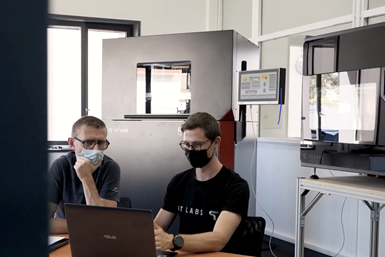Setforge Begins Hybrid Series Production of Composites
Hybrid composite manufacturing has enabled Setforge to expand into new markets with cost-competitive parts that handle higher specific loads than steel.
Setforge Group is a venerable machining and forging company, one which produces high-volume, precision metal components for the automotive and aerospace industries. Despite this long history, however, the company remains eager to invest in new technologies, and it has partnered with hybrid manufacturing solution OEM 9T Labs AG to serially manufacture high-performance carbon fiber-reinforced composite parts on 9T’s Red Series Additive Fusion Solution.

9T Labs’ hybrid manufacturing solution has opened new markets to Setforge while enabling production of optimized parts that carry specific loads four times higher than steel. Photo courtesy of 9T Labs.
Molding Meets AM
“Hybrid” manufacturing combines 3D printing and some form of conventional manufacturing—in this case, molding. 9T Labs’ hybrid advanced manufacturing technology enables users to produce high-performance structural parts in carbon fiber-reinforced thermoplastic composites in production volumes ranging from 100 to 10,000 parts per year. The company says that by combining the design freedom of 3D printing with the swift, repeatable production of compression molding in matched metal dies, its hybrid system combines the strengths of additive and subtractive manufacturing.
The Red Series Additive Fusion Solution platform consists of a build module — a 3D printer providing fiber layup and preform production — and a fusion module — the compact compression press conducting preform consolidation and final part forming. 9T Labs’ Fibrify design suite enables users to import CAD files, optimize the part design and fiber layups, then move the files into separate structural analysis programs to verify structural performance. This optimization and simulation eliminates a large portion of the prototyping cycle, helping manufacturers bring parts to market faster and at lower cost.
“The combination of additive manufacturing and molding is unique,” says Damien Felix, Setforge’s R&D project manager. “We can offer structural parts that are reproducible and cost competitive. The Fibrify software enables us to design the parts with fiber that we can place only where needed, and it’s directly linked with commercially available structural simulation software. 9T Labs’ expertise in composites helps us to identify the right application and to design load-tailored parts easily. If needed, we can even place metal inserts before we densify the fibers and reduce porosity. We end up with finished, net-shape parts with high fiber ratios and low porosity that carry four-times higher specific load than steel.”
Replacing Metal on the Market
Setforge will initially be able to produce up to 5,000 carbon composite parts per year in sizes up to 350 mm × 270 mm × 250 mm. As capacity ramps up in 2023 and beyond, Setforge expects to be able to produce 100,000 parts per year and to extend part dimensions.
The system will cost-effectively produce complex thermoplastic composites such as high-performance neat (unreinforced) and carbon fiber-reinforced polyamide 12 (PA12), polyphenylenesulfide (PPS), polyetherketoneketone (PEKK) and Polyetheretherketone (PEEK). The resulting lightweight parts will be able to replace metals in challenging environments with lower waste, excellent buy-to-fly ratio and high repeatability. Since the thermoplastic matrices may be melt reprocessed, users can recycle scrap metal and parts and weld multiple 3D-printed subassemblies during the Fusion step.
“We end up with finished, net-shape parts with high fiber ratios and low porosity that carry four-times higher specific load than steel,” Felix says.
“With the Red Series, we want to replace metal parts with composites for our current markets like automotive and aerospace, but we also want to propose innovative solutions for markets new to us,” Felix continues. “For example: luxury, sports, medical, exoskeletons (wearable ergonomic lift-assist systems) and drones.”
Didier Henry, director of Setforge, says that he sees use for composite parts produced on the Red Series system in “any market dominated by aluminum and titanium, or everywhere massive, strong, lightweight parts are valuable. These parts will even be of interest to replace other composite parts that have to be improved, lightened and made stronger.”
Related Content
How AM Enables Cobot Automation for Thyssenkrupp Bilstein (Includes Video)
The shock absorber maker has responded to its staffing shortages through extensive use of collaborative robots. In-house 3D printing makes this possible by providing the related hardware needed to complete the cobot-automated cells.
Read More8 Cool Parts From RAPID+TCT 2022: The Cool Parts Show #46
AM parts for applications from automotive to aircraft to furniture, in materials including ceramic, foam, metal and copper-coated polymer.
Read MoreWhat Does Additive Manufacturing Readiness Look Like?
The promise of distributed manufacturing is alluring, but to get there AM first needs to master scale production. GKN Additive’s Michigan facility illustrates what the journey might look like.
Read More3D Printed Cutting Tool for Large Transmission Part: The Cool Parts Show Bonus
A boring tool that was once 30 kg challenged the performance of the machining center using it. The replacement tool is 11.5 kg, and more efficient as well, thanks to generative design.
Read MoreRead Next
3D Printing Brings Sustainability, Accessibility to Glass Manufacturing
Australian startup Maple Glass Printing has developed a process for extruding glass into artwork, lab implements and architectural elements. Along the way, the company has also found more efficient ways of recycling this material.
Read MoreAt General Atomics, Do Unmanned Aerial Systems Reveal the Future of Aircraft Manufacturing?
The maker of the Predator and SkyGuardian remote aircraft can implement additive manufacturing more rapidly and widely than the makers of other types of planes. The role of 3D printing in current and future UAS components hints at how far AM can go to save cost and time in aircraft production and design.
Read More4 Ways the Education and Training Challenge Is Different for Additive Manufacturing
The advance of additive manufacturing means we need more professionals educated in AM technology.
Read More










.png;maxWidth=300;quality=90)












